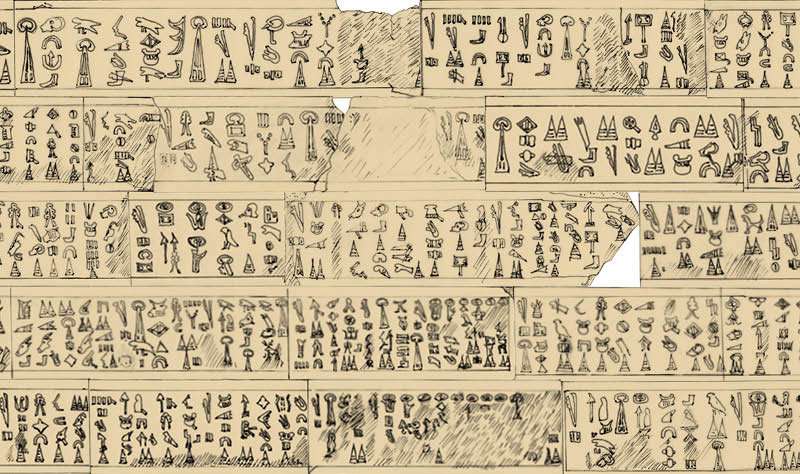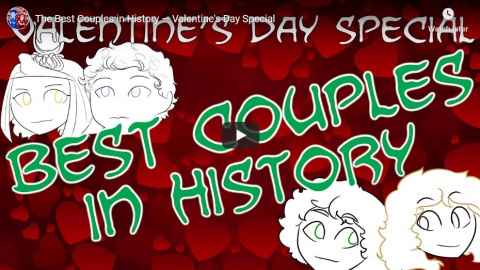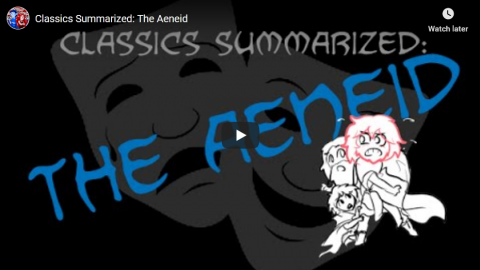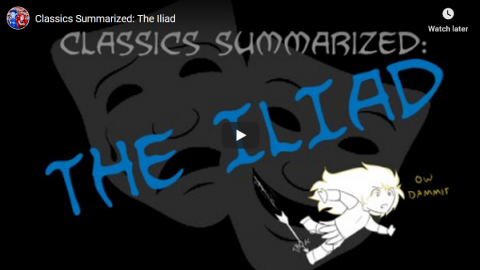Overly Sarcastic Productions
Published 14 Feb 2020Happy Valentine’s Day! Celebrate the history of Love with a rundown of these outstanding couples — for better and for worse.
Our content is intended for teenage audiences and up.
This video was edited by Sophia Ricciardi, AKA “Indigo”.
PATREON: https://www.Patreon.com/OSP
DISCORD: https://discord.gg/h3AqJPe
MERCH LINKS: https://www.redbubble.com/people/OSPY…OUR WEBSITE: https://www.OverlySarcasticProductions.com
Find us on Twitter https://www.Twitter.com/OSPYouTube
Find us on Reddit https://www.Reddit.com/r/OSP/
February 15, 2020
The Best Couples in History — Valentine’s Day Special
February 9, 2020
Classics Summarized: The Aeneid
Overly Sarcastic Productions
Published 28 Jul 2015The epic conclusion that no-one asked for! Virgil steps up to the plate and finishes the trilogy that Homer never expected to be a trilogy.
PATREON: https://www.patreon.com/user?u=4664797
Find us on Twitter @OSPYouTube!
January 28, 2020
Classics Summarized: The Iliad
Overly Sarcastic Productions
Published 23 Jan 2015I’m baaaaaaaack!
This one took me a while. The reason why should be pretty obvious. Enjoy your adorable murderfest.
Troy may be a good movie (though I have my doubts) but it sure as hell isn’t the Iliad.
PATREON: https://www.patreon.com/user?u=4664797
Find us on Twitter @OSPYouTube!
October 30, 2019
Homer, the Trojan War & the Late Bronze Age Collapse
History Time
Published 20 Mar 2018This is the first in a new series I will be producing on the Late Bronze Age Collapse.
If you enjoyed this video and would like to see more then please consider supporting me on Patreon:-
https://www.patreon.com/historytimeUK (every dollar helps)Are you a budding artist, illustrator, cartographer, or music producer? Send me a message at petekellywriter@gmail.com No matter how professional you are or even if you’re just starting out, I can always use new music and images in my videos. Get in touch! I’d love to hear from you.
I’ve compiled a reading list of my favourite history books via the Amazon influencer program. If you do choose to purchase any of these incredible sources of information then Amazon will send me a tiny fraction of the earnings (as long as you do it through the link) (this means more and better content in the future) I’ll keep adding to and updating the list as time goes on:-
https://www.amazon.com/shop/historytimeI try to use copyright free images at all times. However if I have used any of your artwork or maps then please don’t hesitate to contact me and I’ll be more than happy to give the appropriate credit.
December 8, 2018
The Iliad – what is it really about?
Lindybeige
Published on 4 Mar 2016The Iliad – Homer’s epic poem of Achilles and the Trojan War. It was the Bible of its day, but what is it really about? Spoilers!
Support me on Patreon: https://www.patreon.com/Lindybeige
Here I summarise the plot of the Iliad, which may surprise and disappoint those who thought that it was the story of the Trojan War, and then describe and illustrate one of its main themes: the glory and tragedy of war; and then go on to point out the crucial scene of the poem, in which Priam begs for the return of the body of his son, and argue that this is actually the scene that gives meaning to the piece.
Lindybeige: a channel of archaeology, ancient and medieval warfare, rants, swing dance, travelogues, evolution, and whatever else occurs to me to make.
▼ Follow me…
Twitter: https://twitter.com/Lindybeige I may have some drivel to contribute to the Twittersphere, plus you get notice of uploads.
website: www.LloydianAspects.co.uk
December 2, 2017
Great Movie Fighting Techniques as illustrated by Helen of Troy
Lindybeige
Published on 31 Jan 2014This video played fine within Sony Vegas Studio, but very oddly in Windows Media Player. On YouTube it seems to be part way between the two. I just wish my videos would look and sound the way I set them in the editing software. No matter – this will have to be good enough. I have delayed uploading it too long already.
This feature film (also broadcast as a mini-series) has I think enough commentable material in it for one more video.
November 27, 2017
Sea Peoples: The 1200 BC System Collapse
Space And Intelligence
Published on 7 May 2017In the 12th century B.C., after centuries of brilliance, the civilized and globalized world of the Bronze Age came to an abrupt and cataclysmic end. Kingdoms fell like dominoes over the course of just a few decades. No more Minoans or Mycenaeans. No more Trojans, Hittites, or Babylonians. The thriving economies and cultures of the late second millennium B.C., which had stretched from Greece to Egypt and Mesopotamia, suddenly ceased to exist, along with writing systems, technology, and monumental architecture. Could it happen again?
October 15, 2017
The end of the Bronze Age
Colby Cosh linked to an article discussing a convoluted survival from about 1180BC (the image was preserved, but the work itself was destroyed in the late 19th century), which casts some light on the fall of the great Bronze Age cultures of the eastern Mediterannean:

Luwian Hieroglyphic inscription by the Great King of Mira, Kupanta-Kurunta, composed at about 1180 BC.
Credit: Luwian Studies
The 35-cm tall limestone frieze was found back in 1878 in the village of Beyköy, approximately 34 kilometers north of Afyonkarahisar in modern Turkey. It bears the longest known hieroglyphic inscription from the Bronze Age. Soon after local peasants retrieved the stones from the ground, the French archeologist Georges Perrot was able to carefully copy the inscription. However, the villagers subsequently used the stones as building material for the foundation of their mosque.
From about 1950 onwards, Luwian hieroglyphs could be read. At the time, a Turkish/US-American team of experts was established to translate this and other inscriptions that during the 19th century had made their way into the collections of the Ottoman Empire. However, the publication was delayed again and again. Ultimately, around 1985, all the researchers involved in the project had died. Copies of these inscriptions resurfaced recently in the estate of the English prehistorian James Mellaart, who died in 2012. In June 2017, Mellaart’s son Alan handed over this part of the legacy to the Swiss geoarcheologist Dr. Eberhard Zangger, president of the Luwian Studies foundation, to edit and publish the material in due course.
[…]
The inscription and a summary of its contents also appear in a book by Eberhard Zangger that is being published in Germany today: Die Luwier und der Trojanische Krieg – Eine Forschungsgeschichte. According to Zangger, the inscription was commissioned by Kupanta-Kurunta, the Great King of Mira, a Late Bronze Age state in western Asia Minor. When Kupanta-Kurunta had reinforced his realm, just before 1190 BC, he ordered his armies to storm toward the east against the vassal states of the Hittites. After successful conquests on land, the united forces of western Asia Minor also formed a fleet and invaded a number of coastal cities (whose names are given) in the south and southeast of Asia Minor, as well as in Syria and Palestine. Four great princes commanded the naval forces, among them Muksus from the Troad, the region of ancient Troy. The Luwians from western Asia Minor advanced all the way to the borders of Egypt, and even built a fortress at Ashkelon in southern Palestine.
October 10, 2017
Crap archery in Helen of Troy
Lindybeige
Published on 9 Jan 2014This film continues to be a mine of errors, and there were so many on archery, that I thought I could do a whole video on this one subject.
On the speed of arrows, I was assuming the belly of the horse to be 12 feet above the archers. The first arrow to arrive took 20 frames to get there, which is 4/5 second (PAL 25 frames per second), and 5/4 of 12 is 15, so they were travelling at about 15 feet per second.
On opposed landings, I could give the example of the British liberation of the Falkland Islands. Even though there were not vast numbers of Argentinians on the Islands, and the British had air and sea superiority, the British still chose to land unopposed the other side of the islands and walk all the way across, rather than risk an opposed landing. In the ancient world, I do not know of a successful attack on a fortified place from the sea. When the Romans cleared the Mediterranean of pirates, they did it by landing troops away from the pirate strongholds, and then marching to the strongholds overland.
www.LloydianAspects.co.uk
October 7, 2017
The Trojan War – A tale of Passion and Bloodshed! l HISTORY OF SEX
IT’S HISTORY
Published on 23 Sep 2015The Trojan War is one of the most epic and passionate legends set in Greek Mythology. Legend has it, that Prince Paris fell in love with the beautiful Helena, wife of King Menelaos of Sparta. He took her to Troy, which sent all of the rest of Greece, including the famous warrior Achilles after the city. We’ll explain which incidents on the battles are actually proven and how sex, powerplay and love is interpreted to have led to blood shed more than once during Antiquity. Join Indy for our new episode of BATTLEFIELDS!







